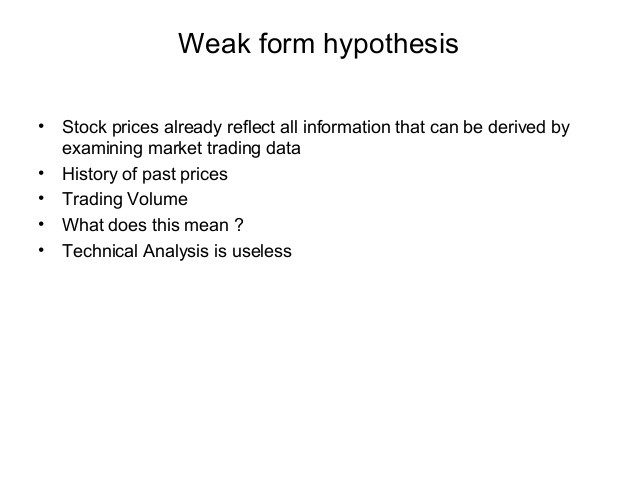The History of the Efficient Market Hypothesis
Post on: 7 Май, 2015 No Comment

Investors pump money into the stock market in order to generate a return on the money theyve invested. While many investors simply try to generate a return, others also try to outperform the market. However, the efficient market hypothesis, or EMH, suggests that current prices provide a complete reflection of all of the information available for a particular market or stock.
According to the EMH, investors cannot have an advantage in predicting stock returns because no one investor is able to access information that isn’t already available to every other investor. From a historical perspective, the random walk hypothesis, efficient market hypothesis, and eventually the Martingale model are closely linked.
Origins of the Efficient Market Hypothesis
Jules Regnault, a French broker, is credited for being the first to model the random nature of stock prices in 1863. Louis Bachelier, a French mathematician, later expounded upon Regnault’s work in his “The Theory of Speculation” PhD thesis in 1900.
Although independent work beginning in the 1930s corroborated Bachelier’s work, it was largely ignored until the mid-1950s. The other work in question indicated that stock prices in the US followed a random walk model, and research in the 30’s and 40’s by Alfred Cowles and others found that investors are for the most part unable to beat the market.
Development of the Efficient Market Hypothesis
That being said, the efficient market hypothesis was itself developed in the early 1960s by Eugene Fama, a professor at the University of Chicago’s Booth School of Business, as an academic concept that followed his published PhD thesis. Fama’s study of macroeconomics and finance led him to determine that the market is transparent, meaning every investor has access to any company information that may affect its stock price. According to Fama, this applies to both growth and value stocks.
As mentioned, the efficient market hypothesis became a popular theory in the mid-1960s. During this time, Paul Samuelson began showing Bachelier’s work to economists. Subsequently, the studies mentioned above and Bachelier’s dissertation were published in an anthology. A year later, in 1965, Fama’s dissertation arguing for the random walk hypothesis was also published.
When a stock decides to conflict with the EMH and fluctuate, investors are still able to profit from price differences. This process is commonly known as arbitrage, and interestingly, it only occurs in inefficient markets. According to the “random walk” model from which the efficient market hypothesis is based, stock prices are inherently unpredictable and past performance is not an indicator of future returns.
Fama published a review of the efficient market hypothesis theory and the evidence supporting the hypothesis in 1970. In addition to refining and extending the theory, the paper also included the introduction of three types of financial market efficiency: strong, semi-strong, and weak.
The efficient market hypothesis has led to the development of many theories and models that support, reject, or modify the EMH. Weak efficiency states that all of a stock’s previous prices are reflected in its current price. Semi-strong efficiency states that an investor can only benefit from non-public information simply because the stock price already accounts for all available public information. On the other hand, according to strong efficiency, such as the EMH, all information both public and private is represented in the price of a stock. Therefore, no investor is able to beat the market, even those with illegal insider information.
The Gradual Fall From Grace
Fama’s efficient market hypothesis was widely accepted until behavioral finance economists transcended from the fringe to the mainstream in the 1990s. Despite being a widely accepted theory for 30 years, empirical analysis has consistently identified problems with efficient market hypothesis. The most common problem is the belief that stocks with low book value or price-to-earnings outperform other stocks.
According to behavior finance economists, these inefficiencies are the result of cognitive biases, which cause investors to pass up value stocks for overinflated growth stocks. Despite becoming a controversial theory due to its obvious inefficiencies, some consider the efficient market hypothesis to be a worthwhile starting point for investors.
Although the efficient market hypothesis is evident throughout modern financial theory, it is a highly controversial subject amongst economists and professional investors. Proponents of efficient market theory believe it is pointless to try to predict market trends through technical or fundamental analysis or to hunt for undervalued stocks.
Meanwhile, although academics frequently refer to the large body of supporting evidence in favor of EMH, dissension exists amongst the ranks due to the persuasive evidence against EMH as well. For example, Warren Buffet has proven time and time again that he can consistently beat the market over extended periods of time. According to the EMH, his results should be impossible. EMH antagonists also point out events like the 1987 market crash, which resulted in a massive 20 percent drop of the Dow Jones Industrial Average in a single day, providing a solid argument against the efficient market hypothesis.














